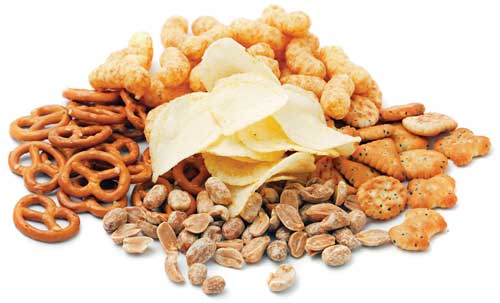Research Insights Spur Ingredient Developments
INGREDIENTS
 As the food industry continually adapts to the changing needs and concerns of consumers—from convenient, healthful food options and bold, authentic flavors to free-from and clean label—market research and academic studies are guiding ingredient manufacturers to develop ingredient solutions that meet these needs and many more. This month’s Ingredients column diverts from its usual coverage of a single topic to give you a sampling of some recent insights into food and consumer trends and a look at several newly published journal articles that may help guide ingredient manufacturers and product developers to answer the needs of consumers and solve functionality challenges.
As the food industry continually adapts to the changing needs and concerns of consumers—from convenient, healthful food options and bold, authentic flavors to free-from and clean label—market research and academic studies are guiding ingredient manufacturers to develop ingredient solutions that meet these needs and many more. This month’s Ingredients column diverts from its usual coverage of a single topic to give you a sampling of some recent insights into food and consumer trends and a look at several newly published journal articles that may help guide ingredient manufacturers and product developers to answer the needs of consumers and solve functionality challenges.
Trends Influencing Ingredient and Product Development
Understanding what the significant trends affecting the food industry are gives product developers insights into what types of food and beverage products consumers want. Food shows and market research are two platforms that present information about what consumers want and how to formulate food and beverage products that meet these demands. Food shows give food developers the opportunity to learn about food ingredients and sample their functional and nutritional benefits in product concepts as a way to inspire their own formulation efforts. From market research data, product developers can glean insights into overall consumer and product trends, delve more deeply into product categories, learn about specific details of consumers’ attitudes toward certain foods and ingredients, and better understand how particular food categories are changing within the overall food and beverage industry.
One of the industry’s largest food shows, IFT16, presented by the Institute of Food Technologists, features hundreds of ingredient manufacturers, some of whom developed product concepts that highlight the ways in which their ingredients can add functional and/or nutritional benefits to foods and beverages while playing into the latest food product trends. For instance, the U.S. Dairy Export Council, Arlington, Va. (thinkusadairy.org), plans to incorporate various types of dairy protein ingredients into three product concepts—a samosa hybrid, cottage cheese mango dip, and yogurt barley soup—that focus on the trends of increasing high-quality protein in the diet and consuming protein-rich foods throughout the day. Flavoring manufacturers will offer product concepts inspired by global and regional American trends in order to answer consumer demands for authentic or adventurous flavors. Gold Coast Ingredients, Commerce, Calif. (goldcoastinc.com), will serve ice cream in Thai coconut curry, Japanese miso, and chicken and waffles varieties while Sensient Flavors, Hoffman Estates, Ill. (sensientflavorsandfragrances.com), and Sensient Natural Ingredients, Turlock, Calif. (sensientnaturalingredients.com), will showcase grilled jerk chicken tacos with hatch green chili dressing and grilled peri chicken skewers and black-eyed pea, lentil, and rice salad with peri pepper dressing.
Reducing sodium and sugar in the diet is getting more attention as the U.S. Food and Drug Administration in June released draft guidance for voluntarily reducing sodium in processed foods and in May announced that the amount of added sugars would be highlighted on the new Nutrition Facts label. Ingredients like yeast extracts, mushrooms, meat and fish powders, and even salt in various crystal sizes can be used to enhance the salty and savory tastes in reduced-sodium applications while sweeteners like allulose, stevia, and more give a sweet taste with less added sugar and fewer calories.
Recent market research related to the food and beverage industry tells a lot about how consumer behavior and other factors drive product development. Some of the research details general, overarching themes while other research drills down into specific areas within the industry. One of the more timely analyses of consumer behavior looks at consumer usage of the Nutrition Facts label. Some of the changes required by the new rule include how the calorie count will be displayed, serving sizes that more closely reflect the amount of product that consumers are actually eating/drinking, and inclusion of a line denoting the grams and percent daily value of added sugars. But will consumers really care? Ongoing food consumption research from The NPD Group’s NPD Dieting Monitor indicates consumer engagement with the Nutrition Facts label has actually decreased over the past decade; fewer people today say that they look at the labels than 10 years ago (NPD 2016). Consumers who do read the labels report that calorie information is important, but the NPD research indicates that consumers are also checking for the amount of sugar, sodium, total fat, and total carbohydrates. One of the food and beverage industry analysts for the organization, Darren Seifer, says that one of the reasons that some consumers do not read the label is that it has not been updated in more than 20 years. “The fact that there is a new label and it will be more reflective of consumer interests and how they actually eat may recapture their interest,” he says in a company press release.
 Listing the amount of added sugar on the revamped Nutrition Facts label is just one more factor influencing the food industry to develop new sugar alternatives and reformulate products to contain less added sugar. Indeed, ingredient manufacturers are exploring the range of sweetener possibilities by developing new versions of stevia, blending sweeteners that provide optimal taste and function, and using fermentation or enzymatic processes to create sweeteners. New information published by Innova Market Insights finds that concerns about obesity, sugar intake, and so-called sugar taxes that have been implemented by some governments around the world, along with the interest in clean labeling, has increased the use of naturally derived sweetener alternatives in applications like soft drinks (Innova 2016a). Data from a 2015 Innova Market Insights survey show that the sugar content influences the purchasing decision of 57% of consumers in Mexico (Mexico has a sugar tax in place), 60% of consumers in the United Kingdom (a sugar tax will become effective in 2018), and 57% of consumers in the United States. In the 12 months to the end of March 2016, more than 16% of global soft drink launches noted by Innova used either a no-added-sugar, low-sugar, or sugar-free claim. And Innova points out that the usage of sweeteners perceived as clean label is growing in sugar-reduction efforts. John Fry, director of Connect Consulting, says that beverages formulated with only naturally derived sweeteners like stevia and monk fruit may become available in the United States in two to three years (Innova 2016b).
Listing the amount of added sugar on the revamped Nutrition Facts label is just one more factor influencing the food industry to develop new sugar alternatives and reformulate products to contain less added sugar. Indeed, ingredient manufacturers are exploring the range of sweetener possibilities by developing new versions of stevia, blending sweeteners that provide optimal taste and function, and using fermentation or enzymatic processes to create sweeteners. New information published by Innova Market Insights finds that concerns about obesity, sugar intake, and so-called sugar taxes that have been implemented by some governments around the world, along with the interest in clean labeling, has increased the use of naturally derived sweetener alternatives in applications like soft drinks (Innova 2016a). Data from a 2015 Innova Market Insights survey show that the sugar content influences the purchasing decision of 57% of consumers in Mexico (Mexico has a sugar tax in place), 60% of consumers in the United Kingdom (a sugar tax will become effective in 2018), and 57% of consumers in the United States. In the 12 months to the end of March 2016, more than 16% of global soft drink launches noted by Innova used either a no-added-sugar, low-sugar, or sugar-free claim. And Innova points out that the usage of sweeteners perceived as clean label is growing in sugar-reduction efforts. John Fry, director of Connect Consulting, says that beverages formulated with only naturally derived sweeteners like stevia and monk fruit may become available in the United States in two to three years (Innova 2016b).
Other research points out key product categories, consumer behavior, and ingredients to keep an eye on. The popularity of salty snacks is growing, being driven by an unlikely suspect: stressed-out Americans, according to market research firm Mintel (Mintel 2016). A newly published report from the company found that 62% of American consumers eat salty snacks as a stress reliever compared to 16% one year ago. More consumers snack when they are bored; 30% eat salty snacks when they are bored (the number was 25% in 2015), and 51% agreed that eating salty snacks is a good way to relieve boredom. It is not only daily stresses driving consumers to consume salty snacks; health concerns are factoring in too with 13% of American consumers replacing meals with salty snacks and 75% of consumers expressing interest in healthier salty snack options, according to the Mintel research. More than half (58%) of consumers who purchase salty snacks agree that it is important to buy salty snacks that contain only a few ingredients. Additional points to consider are that taste is still important in choosing salty snacks and that new flavors, spicy flavors, and limited-edition/seasonal flavors are influential in consumers’ decisions about salty snacks.
 Perhaps product developers of salty snacks looking to formulate a tasty, healthier salty snack that both health-conscious and stressed (or bored) consumers would like might want to consider one of the trending superfoods. Turmeric, ancient grains, moringa, pulses, and seeds, are some of the “new faces in superfoods” that are turning up in products on store shelves around the world, writes Stephanie Mattucci, Mintel’s global food science analyst, in the company blog (Mattucci 2016). In 2015, the United States had the most “super” food and beverage launches. Consumer demand for highly nutritious products is driving this, and the Mintel research found that 72% of consumers in France, 71% in Germany, 73% in Italy, and 72% in Spain agree that health-promoting benefits of natural foods are preferable to the added benefits of functional foods.
Perhaps product developers of salty snacks looking to formulate a tasty, healthier salty snack that both health-conscious and stressed (or bored) consumers would like might want to consider one of the trending superfoods. Turmeric, ancient grains, moringa, pulses, and seeds, are some of the “new faces in superfoods” that are turning up in products on store shelves around the world, writes Stephanie Mattucci, Mintel’s global food science analyst, in the company blog (Mattucci 2016). In 2015, the United States had the most “super” food and beverage launches. Consumer demand for highly nutritious products is driving this, and the Mintel research found that 72% of consumers in France, 71% in Germany, 73% in Italy, and 72% in Spain agree that health-promoting benefits of natural foods are preferable to the added benefits of functional foods.
Timely Research Into Food Science Topics
Peer-reviewed research provides a wealth of information about food science and ingredients that builds upon previous research and advances in the industry. Here are a few studies that cover such diverse topics as which ingredients are more suited to enrich pasta products and how X-ray technology can give researchers new insights into the structure of edible fats.
First up is research from scientists at Chr. Hansen, Hørsholm, Denmark (chr-hansen.com), who developed a method that reduces the sugar content of yogurt but still keeps it sweet, through modified strains of bacteria (Sørensen et al. 2016). The modification involved using a series of selection steps to isolate spontaneous mutants of industrial strains of Streptococcus thermophiles and Lactobacillus delbrueckii subsp. bulgaricus that metabolize galactose rather than glucose during the fermentation of milk. The unmodified versions of these bacteria break down lactose and consume glucose and secrete galactose. Glucose is much sweeter than lactose or galactose. By consuming galactose and leaving glucose behind, the modified bacteria strains produce a yogurt with a heightened sweetness perception.
--- PAGE BREAK ---
 Fat carries flavor and has an important role in the taste and texture of many foods. Researchers from the University of Guelph are using X-ray technology at Argonne National Laboratory to study the molecular structure of fat to gain a better understanding of what makes foods like chocolate and cheese taste so good (Argonne 2016). For three years, the researchers have examined many samples of edible fats at different temperatures (the structures are different at different temperatures). The researchers use an ultra-small angle-scattering camera to produce X-ray scattering data that give them the opportunity to closely examine the hierarchical structures and crystal networks of fat samples in 3-D at different temperatures without altering the samples. The first fats that they analyzed were tristearin, a saturated solid found in some animal and plant fats, and triolein, an unsaturated liquid fat. From there they studied the structures of edible oils such as fully hydrogenated canola oil and soybean oil, cotton seed oil, and sunflower oil. This year, they examined anhydrous milk fat, which is derived from cream or butter and is more than 99% fat. They say that the data they collect can help food manufacturers understand the structures of the different fats to mimic the tastes and textures of unhealthy fats with healthier alternatives.
Fat carries flavor and has an important role in the taste and texture of many foods. Researchers from the University of Guelph are using X-ray technology at Argonne National Laboratory to study the molecular structure of fat to gain a better understanding of what makes foods like chocolate and cheese taste so good (Argonne 2016). For three years, the researchers have examined many samples of edible fats at different temperatures (the structures are different at different temperatures). The researchers use an ultra-small angle-scattering camera to produce X-ray scattering data that give them the opportunity to closely examine the hierarchical structures and crystal networks of fat samples in 3-D at different temperatures without altering the samples. The first fats that they analyzed were tristearin, a saturated solid found in some animal and plant fats, and triolein, an unsaturated liquid fat. From there they studied the structures of edible oils such as fully hydrogenated canola oil and soybean oil, cotton seed oil, and sunflower oil. This year, they examined anhydrous milk fat, which is derived from cream or butter and is more than 99% fat. They say that the data they collect can help food manufacturers understand the structures of the different fats to mimic the tastes and textures of unhealthy fats with healthier alternatives.
Pasta is a popular food product for both consumers who enjoy it as an easy-to-prepare, affordable food and for product developers looking to enrich it with different types of ingredients. Flours made of different grain and protein sources, protein concentrates and isolates, dietary fibers, fruit extracts, and microalgae have all been tested as potential ingredients to enrich pasta or replace gluten. Researchers have even formulated a pasta product with a small percentage of beta-glucan-rich fractions derived from king oyster mushrooms to produce pasta with an increased amount of dietary fiber and acceptable sensory qualities (Kim et al. 2016). A meta-analysis of 66 studies on enriched pasta found that the quality attributes of the pasta are affected by the type of ingredient used as well as processing conditions (Mercier et al. 2016). Some of the conclusions include that high-fiber ingredients preserved the quality attributes of pasta better than pulse flour, enrichment levels at or less than 10% resulted in pasta with sensory properties similar to traditional pasta, and that, in general, high drying temperatures (greater than 60°C) improved the cooking properties of enriched pasta.
Consumers expect their meat and seafood to have a pleasant balance of moisture and taste. Two teams of researchers have developed ways that might help to achieve this; one examined ways to make steak juicier without increasing the overall fatness of it while the other found an alternative to phosphates that retains moisture in shrimp. The key to ensuring a juicier steak comes from increasing marbling, and researchers from Texas Tech University and Texas A&M University are studying ways to do this without increasing fat or cost (Texas Tech 2016). The researchers isolated a receptor in marbling adipocytes to determine that it increases the production of lipids, which, they say, increases the production of marbling without increasing fat. If the receptor can be regulated, marbling can be increased without making the cattle fatter, says Brad Johnson, a researcher at Texas Tech. What’s more, marbling is high in the monounsaturated oleic acid, and the longer that cattle are fed grain or corn, the more an enzyme involved in converting steric acid into oleic acid is produced and the less overall fat is added to the cattle, according to the researchers. To maintain a moist texture in shrimp, researchers at the University of Florida looked at a variety of polysaccharides as alternatives to phosphates, standard moisture retention agents in the shrimp industry that are expensive and need to be listed on the food label (Torti et al. 2016). The study determined that various polysaccharides (fiber colloid from citrus peel, pectin, xanthan gum, and carboxymethyl cellulose) can be used to help retain water in shrimp and are suitable replacements for phosphates. The results found that some of the polysaccharides are less expensive than phosphates and will not change the taste, texture, or appearance of shrimp.
 Seaweed, a common food ingredient in many Asian countries, is now appearing in snack foods such as seaweed chips, often seasoned with salt, pepper, or other seasonings and positioned as a healthier alternative to traditional snack chips. A particular type of seaweed, edible red algae, is high in nutrients and low in calories. Research shows that it might have an additional benefit of helping to alleviate food allergy symptoms (Liu et al. 2016). The researchers write that indigenous people from southeast China ingest marine algae while they simultaneously consume shellfish and that traditional Chinese medical literature notes that the algae improves digestion, immunity, and more. Recent in vitro and in vivo studies have demonstrated the anti-allergic properties of marine algae. In the newly published study, the researchers extracted sulfated polysaccharide from a commercial variety of red algae and found that it had immunosuppression activity. They write that it may one day be used as a functional food component for people who suffer from food allergies.
Seaweed, a common food ingredient in many Asian countries, is now appearing in snack foods such as seaweed chips, often seasoned with salt, pepper, or other seasonings and positioned as a healthier alternative to traditional snack chips. A particular type of seaweed, edible red algae, is high in nutrients and low in calories. Research shows that it might have an additional benefit of helping to alleviate food allergy symptoms (Liu et al. 2016). The researchers write that indigenous people from southeast China ingest marine algae while they simultaneously consume shellfish and that traditional Chinese medical literature notes that the algae improves digestion, immunity, and more. Recent in vitro and in vivo studies have demonstrated the anti-allergic properties of marine algae. In the newly published study, the researchers extracted sulfated polysaccharide from a commercial variety of red algae and found that it had immunosuppression activity. They write that it may one day be used as a functional food component for people who suffer from food allergies.
Partnerships Drive Innovation
A final example of ingredient research springs from a collaboration between QUALISOY, Chesterfield, Mo. (qualisoy.com), and Stratas Foods, Memphis, Tenn. (stratasfoods.com). The experiment on cake doughnut deep frying showed that enzymatically interesterified (EIE) high oleic soybean oil produced doughnuts similar to those made with partially hydrogenated soybean oil in terms of color, mouthfeel, and texture.
Manufacturers are in the process of reformulating foods without partially hydrogenated oils (PHOs) in response to the FDA’s decision last year to remove the generally recognized as safe (GRAS) status of PHOs. “Because of the flexibility of the PHO process, there have been hundreds of PH oils developed and used by the food industry, each with their own unique set of specs, performance, and functionality,” says Frank Flider, oils expert for QUALISOY. “Initially, there have been attempts made to develop ‘blends’ of hard fats and liquid oils to replace PHOs. While this was suitable for some applications, there are a number of deficiencies to these replacement blends, including lack of oxidative stability, flavor issues, and melting point limitations.” Whichever PHO replacer is chosen, it is important that it produces a finished product that the consumer accepts, meaning no changes in flavor, mouthfeel, shelf-life, and greasiness. “This is often very difficult to achieve with blended oils. Through enzymatic interesterification with high oleic soybean oil as the liquid, virtually every PH fat or oil can be adequately replaced with a zero trans solution in a functional, sensory, and oxidatively stable fashion,” explains Flider.
 To produce an EIE soybean oil, Flider says that fully hydrogenated soybean oil and high oleic soybean oil are mixed together and then lipase enzymes are added to remove and reattach the fatty acids in a random fashion, but only at the 1- and 3- positions of the triglyceride. This results in a shortening that closely resembles partially hydrogenated shortenings but without trans fatty acids. “Enzymatic interesterification may be envisioned somewhat like an ‘artist’s palette’—it provides a set of tools to enable development of ingredients with specific functionalities and attributes,” says Flider. “Like partial hydrogenation, this is an ongoing process. Levels of fully hydrogenated soybean oil and high oleic soybean oil can be varied to achieve different properties. Likewise, introduction of low levels of other oils such as cottonseed can result in oils with different sensory qualities, melting point characteristics, flavors, etc.”
To produce an EIE soybean oil, Flider says that fully hydrogenated soybean oil and high oleic soybean oil are mixed together and then lipase enzymes are added to remove and reattach the fatty acids in a random fashion, but only at the 1- and 3- positions of the triglyceride. This results in a shortening that closely resembles partially hydrogenated shortenings but without trans fatty acids. “Enzymatic interesterification may be envisioned somewhat like an ‘artist’s palette’—it provides a set of tools to enable development of ingredients with specific functionalities and attributes,” says Flider. “Like partial hydrogenation, this is an ongoing process. Levels of fully hydrogenated soybean oil and high oleic soybean oil can be varied to achieve different properties. Likewise, introduction of low levels of other oils such as cottonseed can result in oils with different sensory qualities, melting point characteristics, flavors, etc.”
Next month’s Ingredients section will look at some of the food and ingredient influences of Europe and the Americas.
Consumers Reveal Leading Health Concerns
Various health concerns are top of mind for many consumers, and the concerns change throughout life as people age, according to a survey conducted by DSM, Heerlen, the Netherlands (DSM 2016). The company surveyed 7,000 people across Europe, the Middle East, and Africa to get their insights about their greatest health concerns. Here are some key takeaways of the study.
• Almost half (45%) of people surveyed are worried about not getting the right amount of nutrition.
• Adults aged 18–50 are most concerned about weight, and as they get older (51 years+), they become more concerned with their bone and joint health.
• People in Italy, France, and Egypt are worried about their protection against diseases later in life.
• Eye health is the top concern of those surveyed in Poland and Russia.
• The main concern for people in Sweden, Spain, the United Kingdom, and South Africa is weight.
• Only three out of 10 people surveyed are eating five different types of fruit and vegetables a day and two out of five people eat 2–3 servings of fish a week on average.
--- PAGE BREAK ---
Trending Ingredients for Healthful Products
Food formulators are constantly developing new products or reformulating existing ones to help consumers meet their health and wellness needs. One way that they are doing this is by using ingredients that have demonstrated health benefits. “The top and trendy ingredients in the functional food and beverage market usually differ depending on segment,” says Rikka Cornelia, product manager at BI Nutraceuticals, Rancho Dominguez, Calif. (botanicals.com). “For instance, beet root is trending for sports nutrition while turmeric is trending for inflammation. In a broader view, there are several ingredient categories that are popular amongst a wide range of product applications, from baked goods to beverages to yogurt.” Cornelia points out six ingredient categories that are becoming more popular: ancient grains, fruit and vegetable powders, naturally derived alternatives to artificial ingredients, plant-based proteins, probiotics, and pulses. The driving factor in the increased use of these ingredients, according to Cornelia, is consumer demand for clean label products and plant-based products.
Take a New Look at Sea Salt
Food manufacturers and culinary professionals have a large assortment of ingredients at their disposal that they can use to add excitement and distinction to their food and beverage products. One company wants them to consider an ingredient that has been used for centuries—sea salt.
All salt ingredients—refined table salt and sea salt—provide functional benefits like flavor enhancement and preservative qualities. SaltWorks, Woodinville, Wash. (seasalt.com), a manufacturer of sea salt, promotes its gourmet smoked sea salts and specialty line of flavored sea salts as culinary tools that manufacturers and chefs can use to bring extra layers of flavor and more to their food products. “Sea salts, like so many other foods, have flavor and texture nuances based on where and how they’re harvested,” explains Megan O’Keefe, media relations representative at SaltWorks. “Since SaltWorks salts are never chemically treated or refined, they retain their beautiful color variances, trace mineral content, and natural textures, which allow the salts to be leveraged in a variety of ways in foodservice, manufacturing and processing, and product development. Making the switch to all-natural sea salt can elevate the flavor of a dish or product and add color and crunch in topping or garnishing applications. Utilizing all-natural sea salts can subtly but dramatically improve the consumer’s experience.”
At a time when consumers are encouraged to manage their intake of sodium and food manufacturers are encouraged to reduce the sodium content of foods (the U.S. Food and Drug Administration in June issued draft guidance to the industry for sodium reduction targets and is currently accepting comments on it), sea salt may offer some food manufacturers and chefs an option to reduce sodium. “Because traditional table salt is refined and is a smaller grain size, food manufacturers may need to use more salt in order to impact flavor,” says O’Keefe.
SaltWorks’ smoked sea salts are cold-smoked over bark-free woods without the use of additives like liquid smoke. While the obvious use for these smoked sea salts is in BBQ products and spice rubs, manufacturers should consider them for other applications, including sweet ones. “Salish Alderwood Smoked Salt is a delicious, albeit unexpected, topping for chocolates and truffles,” says O’Keefe. “Yakima Applewood Smoked Salt is incredibly versatile. The small flake offers subtle smoke and a slight sweetness, ideal for garnishing roasted vegetables or grilled poultry, or even sprinkled over vanilla ice cream with a slice of warm apple pie.”
Moving beyond smoky flavors are the sea salts in the Fusion collection. The flavored seas salts in this line are produced using a proprietary process that binds the ingredient—a chili pepper or herb, for example—to the sea salt crystals. They are not mixes of loose ingredients, and the company does not add artificial colorings and flavors of bonding agents to the sea salts, says O’Keefe. With more than 20 varieties, product developers will find one that matches perfectly with many sweet or savory applications. One of the best ways to use them is as a topping “due to their eye-catching colors, grain size, and texture,” says O’Keefe. “Toasted Onion is the perfect partner for pretzels and crackers, while Wild Porcini is ideal for pastas and sauces, breadsticks, or meats. Espresso Brava pairs well with chocolate, but its robust flavor is a surprising and satisfying finish on a steak. Spanish Rosemary is elegant and fragrant, equally at home in an herb blend, seasoning roasted chicken, or sprinkled atop omelets.”
O’Keefe encourages even more creativity with the Fusion sea salts by suggesting uses such as Sriracha Salt sprinkled on fried eggs and avocado toast or used to season popcorn and Ghost Pepper and Scorpion Pepper salts paired with chocolate and other confections for a sweet/salty/spicy combination. Others, like Black Truffle Salt, work well on French fries and other potato products while Thai Ginger Salt can top everything from tempura vegetables and steamed edamame to vanilla ice cream.
 Almond Flour in Gluten-Free Formulas
Almond Flour in Gluten-Free Formulas
“Almond flour is in high demand as a consumer item and as an ingredient for manufacturing,” says Jeff Smith, director of marketing for Blue Diamond Almonds Global Ingredients Division, Sacramento, Calif. (bdingredients.com). “In fact, based on recent market research conducted by Profitero Global eCommerce Intelligence, almond flour ranks among the top 100 food items sold on Amazon.” He also notes that he continues to see new distribution of almond flour in the grocery, club store, and online channels and the use of almond flour in a variety of bakery items, bars, snack products, and as a coating, including gluten-free products. “Perhaps most interesting to a bakery audience is our finding that gluten-free bakery is projected to grow 44% between 2014 and 2018. This and other proof points indicate how strongly consumers have embraced the gluten-free alternative and how promising this category will continue to be. Because 60% of gluten-free sales are in the bakery category, almond flour is perfectly poised to leverage consumers’ continued interest in a gluten-free, or gluten-restricted, diet.” Almond flour, says Smith, has a smooth texture whereas other gluten-free flours can be gritty or have an off-taste. Blue Diamond offers three forms: Extra Fine Blanched Almond Flour, Extra Fine Natural Almond Flour, and Fine Blanched Almond Flour.
Spice and Herb Use Increases
Adding spices and herbs is a sure-fire way to give foods and beverages a boost of flavor and color and provide nutritional benefits. Scientists at Nestlé are even looking at how some spice compounds (cinnamaldehyde, a cinnamon extract, and capsaicin, a chili pepper extract) may help prevent weight gain by increasing energy expenditure and significantly raising fat oxidation levels (Michlig et al. 2016).
The use of herbs, spices, and seasonings in new global product launches tracked by Innova Market Insights increased by 29% from the first half of 2014 to the first half of 2015. Some herbs and spices are quite popular to use in products, according to Innova’s findings; garlic, paprika, turmeric, and vanilla are four of the top five ingredients for all category launches tracked with herbs, spices, and seasonings during that time frame. The fifth is referred to as spices not specified.
Protein Beverage for Older Adults
Using peanuts, flaxseed, and brown rice flour, researchers at the University of Georgia developed a beverage to help supplement diets with protein (Klu et al. 2016). Enzymes were used to predigest starch and protein, making these nutrients more bioavailable to susceptible populations like the elderly. The beverage is high in fiber and potassium, low in sodium, and free of cholesterol. The researchers say that the beverage developed for their study can be further developed into a beverage specifically formulated for older adults to help them maintain recommended protein levels and maintain overall health. The research was partially funded by the United States Agency for International Development through the Peanut Collaborative Research Program.
 Karen Nachay,
Karen Nachay,
Senior Associate Editor
[email protected]
References
Argonne. 2016. “Tasty Fat: X-rays Finding the Blueprint of Why Fat is Yummy.” Press release, May 27. Argonne National Laboratory, Lemont, Ill. anl.gov.
DSM. 2016. “DSM Unveils New Data on Consumers’ Top Health Concerns.” Press release, May 10. DSM, Heerlen, the Netherlands. dsm.com.
Innova. 2016a. “Natural Alternatives Look to Close the Sweetness Gap in Soft Drinks.” Press release, May. Innova Market Insights, Arnhem, the Netherlands. innovadatabase.com.
Innova. 2016b. “Natural Sweeteners: Clear Market Potential.” Webcast, Innova Market Insights, June 1.
Kim, S., J. Lee, Y. Heo, and B. Moon. 2016. “Effect of Pleurotus eryngii Mushroom β-Glucan on Quality Characteristics of Common Wheat Pasta.” J. Food Sci. 81(4): 835–840.
Klu, Y. A. K., R. D. Phillips, and J. Chen. 2016. “Development of a Drinkable, Peanut-Based Dietary Supplement and Comparison of Its Nutritional and Microbiological Qualities with Commercial Products.” J. Food Sci. 81(5): 1309–1312.
Liu, Q., Y. Yang, S. J. Maleki, et al. 2016. “Anti-Food Allergic Activity of Sulfated Polysaccharide from Gracilaria lemaneiformis is Dependent on Immunosuppression and Inhibition of p38 MAPK.” J. Agric. Food Chem. doi: 10.1021/acs.jafc.6b01086.
Mattucci, S. 2016. “Superfoods: The Ones to Watch in 2016.” Mintel Blog: Latest Market News and Trends, May 5. www.mintel.com/blog/food-market-news/superfoods-the-ones-to-watch-in-2016.
Mercier, S., C. Moresoli, M. Mondor, S. Villeneuve, and B. Marcos. 2016. “A Meta-Analysis of Enriched Pasta: What Are the Effects of Enrichment and Process Specifications on the Quality Attributes of Pasta?” Comp. Rev. Food Sci. Food Safety. doi: 10.1111/1541-4337.12207.
Michlig, S., J. M. Merlini, M. Beaumont, et al. 2016. “Effects of TRP Channel Agonist Ingestion on Metabolism and Autonomic Nervous System in a Randomized Clinical Trial of Healthy Subjects.” Scientific Reports. doi: 10.1038/srep20795.
Mintel. 2016. “Stressed Out Americans are Driving the U.S. Salty Snack Market.” Press release, May 10. Mintel, Chicago. mintel.com.
NPD. 2016. “Nutrition Facts Label Overhaul Plan Comes at a Time When Fewer U.S. Consumers Are Looking at the Label.” Press release, May 24. The NPD Group, Port Washington, N.Y. npd.com.
Sørensen, K. I., M. Curic-Bawden, M. P. Junge, T. Janzen, and E. Johansen. 2016. “Enhancing the Sweetness of Yoghurt through Metabolic Remodeling of Carbohydrate Metabolism in Streptococcus thermophiles and Lactobacillus delbrueckii subsp. bulgaricus.” Appl. Environ. Micro. doi: 10.1128/AEM.00462-16.
Texas Tech. 2016. “Researcher’s Work Could Lead to Your Next Juicy Steak.” Press release, May 4. Texas Tech University, Lubbock, Texas. http://today.ttu.edu/posts/2016/05/steak-marbling.
Torti, M. J., C. A. Sims, C. M. Adams, and P. J. Sarnoski. 2016. “Polysaccharides as Alternative Moisture Retention Agents for Shrimp.” J. Food Sci. 81(3): 728–735.
